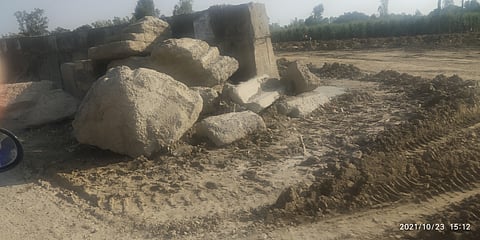Highways Construction Can Be Extremely Lopsided, Erratic Too
One of the most chaotic and punishing experiences any motorist can ever undergo is to travel by national highway 24 from Lucknow to Garhmukteshwar, enroute to New Delhi, or the other way around, linking two extremely significant political centres.
Many stretches of the highway resemble a rather dystopian, war ravaged zone, with gaping craters, mounds of earth or deeply ploughed out soil, leaving little space for the vehicles to manoeuvre. Clouds of dust, a health hazard, blot visibility for hundreds of metres, getting into your eyes and nostrils. Contractors and vendors make no attempt to suppress the grime by spraying it with water.
Imagine how much more stressful the repeated round trips on this route can be for any traveller. He would have to face the same sense of dislocation, jolted out of his wits repeatedly, as the car bumps over badly broken surfaces and contends with a plethora of heavy trucks, SUVs, E-rickshaws, two-wheelers and horse drawn carts jostling for space.
The long suffering Indian public silently acquiesces in its own victimhood at the hands of official agencies. The construction work never seems to be fast tracked despite thousands of crores pouring into toll booths coffers, every year.
Daily, a serpentine queue of vehicles, stretching into the far distance, can be seen waiting patiently on either side of the Katra level crossing in Shahjahanpur, only to inch forward at a snail’s pace, when it does open. But then, in a cruel irony of sorts, when the queue barely advances some 50 metres, the gates shut again for another 40 minutes or more, leaving passengers fuming and stranded.
It takes six or seven frustrating instalments to cross the tracks; thanks to the railway over-bridge that still remains incomplete after 20 odd years! The pillars of the structure loom in the background, with a jumble of rusting iron bars jutting out of them, a mute testimony to decades of official neglect and apathy.
Should a driver feel tempted to cross over into the opposite lane with negligible traffic, a departmental constable poised round the bend materializes, questioning you about the violation of rules and intent on imposing a fine, depending on his whims, especially around festivals.
By the time he allows the car to leave, the gates shut down again, just as the motorist is about to cross the barrier. An aggrieved party might feel inclined to sue authorities for gross laxity, besides failure to deliver the project on time, which in the first place, necessitates the crossover to another lane.
More is to follow. Up ahead the road goes past the galla mandi in Shahjahanpur proper, which trucks and tractor trolleys, laden with the local produce, approach by the thousands, bringing the vehicular movement to a complete standstill for hours.
Decades have passed but the problem remains unresolved, for reasons that are difficult to fathom. Building materials are piled haphazardly along the highway, besides heavy earth moving equipment, concrete mixers, aggravating traffic hazards. Certainly a visitor from abroad would carry highly negative images about our roads.
Besides Katra, the other trouble spot is the stretch passing through Moradabad, where it is being expanded from four to six lanes, creating chaotic traffic bottlenecks, which only gets worse after 12 noon. Most surprisingly, policemen are conspicuous by their absence in the area.
Another bridge, meant to go over the level crossing between Sitapur and Shahjanpur, has been abandoned midway, allegedly because of a land dispute, causing huge traffic snarl-ups with the passage of trains. The jumble of SUVs, sedans, light and heavy commercial vehicles, e-rickshaws, occasionally bullock carts, takes hours to clear up.
The highway, the sole direct link between the state and national capital, only covers half the distance. As many as six toll booths between Garh Mukteshawar and Sitapur, excluding lengthy stretches of the non NHAI zones, charge around Rs 700. The traveller also encounters a number of fully constructed over-bridges, built to accommodate rural underpass, but blocked to traffic most of the time, seemingly on account of repairs.
Thus thousands of vehicles are diverted towards highly congested narrow side lanes, only to be cut off by traffic flowing across. Then there are a number of half complete over-bridges, virtually abandoned for decades, until the National Highway Authority of India (NHAI) belatedly woke up and resumed construction before the election year in 2022.
The Authority never fails to remind the public how it is executing massive projects at a blinding speed, all across the country. Of course this may be true in case of certain high profile works or when the political dispensation specifically wants it. But then why should other some other project like the NH 24 should be allowed to languish, especially in Uttar Pradesh, when every vehicle is being taxed heavily for its use.
Possibly pending work may be speeded up and completed before the election year and touted as a major accomplishment to secure votes. It may be pointed out that travel time between Chandigarh and Karnal on NH 44, a distance of 125 km, has been cut down to less than two hours, while it takes nearly three or more hours to cover a similar distance on NH 24.
--Sudip Talukdar
(Author, Strategic Affairs Columnist)

